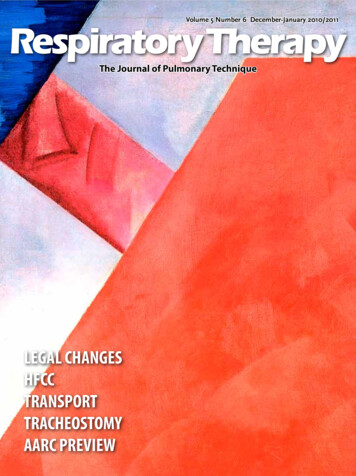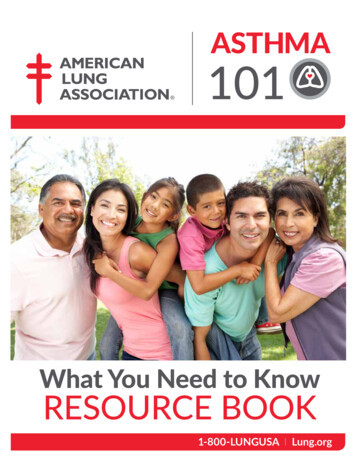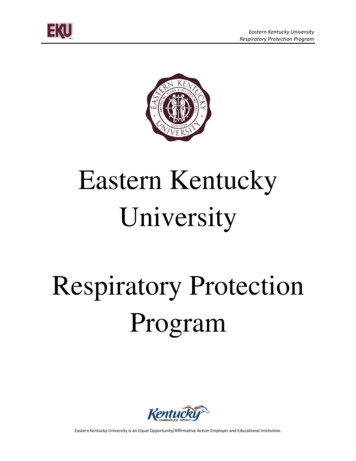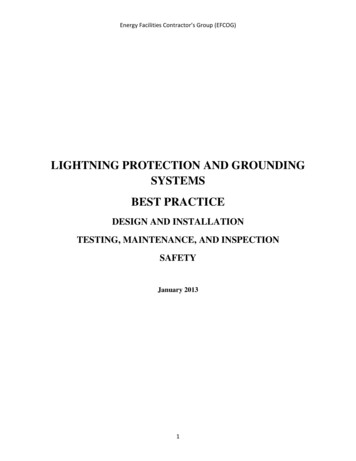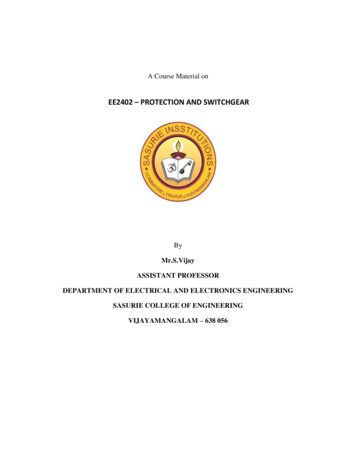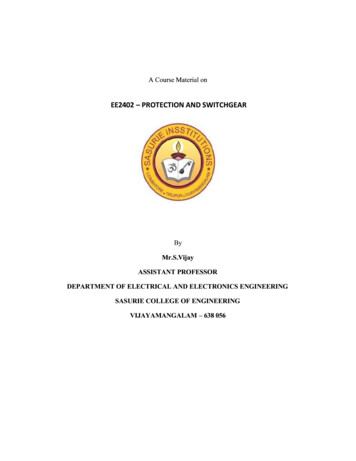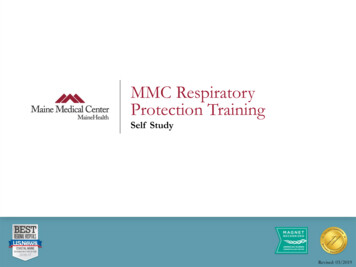
Transcription
MMC RespiratoryProtection TrainingSelf StudyRevised: 03/2019
Training Goals Understand the requirements of MMC’s RespiratoryProtection Program Understand respiratory protection needed at MMC Understand the use and limitations of positive andnegative pressure particulate respirators Understand the processes for inspection, donning,doffing, seal checking and/or flow testing of respirators Understanding the maintenance and storage ofrespirators.2
What is respiratoryprotection? Respiratory protection is a broad term used todescribe a class of Personal Protective Equipment(PPE) that is designed to protect the user frominhaling contaminants that may be harmful tothem. There are many different types of respiratoryprotection, each with their own uses andlimitations. Not all respirators are created equal!3
What is respiratoryprotection? (continued) These are all examples of respiratory protection:4
What is respiratoryprotection? (continued) In a healthcare setting, these three are the most common:Surgical Masks/Patient PPEFiltering Face-pieceRespirators (N95s)Powered Air Purifying Respirator(PAPR) These devices DO NOT all provide the same level ofprotection. In the following slides, you will learn moreabout the different types of respiratory protection.5
What hazards would requireme to wear a respirator? In healthcare settings, the primary contaminants ofconcern are viruses and other illnesses that our patientsmay have.- Typical illnesses that require the use of PPE:» Tuberculosis» Chicken Pox» H1N1» Ebola6
MMC’s RespiratoryProtection Program Maine Medical Center’s respirator program is managed bythe Safety-Emergency Management Department toensure compliance with Occupational Safety and HealthAdministration (OSHA) requirements and MMC’sRespiratory Protection Policy. Selection of respirators is done by the Safety –Emergency Management Department in accordance withOSHA standards. Contact the Safety-Emergency Management Departmentat 662-2513 with any questions about the respiratoryprogram at MMC7
OSHA’s RespiratoryProtection ProgramRequirements Medical evaluations are required for all staff prior tousing any respirator. Initial training is required for all staff prior to using anyrespirator. Initial and annual fit testing is required for all staff usinga negative pressure respirator. Annual refresher training is required for all respiratorsand can be completed by any approved MMC fit tester ortrainer.8
How do I Know WhenRespiratory Protection isRequired?Airborne precautions require that a positive or negativepressure respirator is worn while in the patient room.These patients release infectious particulates that canremain suspended in the air for long periods of time.When conducting any surgical procedures that mayproduce hazardous or infectious particulates. Someexamples of this are: Some procedures that produce surgical plume.(lasers, electro-surgical pencils, ultrasonic devices,and other surgical energy based devices) Endotracheal intubation Open respiratory and airway suctioning Bronchoscopy Pulmonary Function Testing9
Surgical MasksHere are some examples of surgical masks10
Surgical Masks (continued) Surgical masks are designed to capture potentially infectious droplets thatare exhaled by the wearer.- Surgical masks are NOT designed to filter the air that is beinginhaled by the wearer.- Surgical masks are generally used to limit the spread of an illness inorder to protect other people around the wearer. No training or fit testing is required to use a surgical mask. Surgical masks are generally the ONLY appropriate form of respiratoryprotection to give to patients, visitors and staff who have not been fittested.11
N95 RespiratorsHere are some examples of N95 respirators12
N95s (continued) Requirements for wearing an N95 respirator:- Medical clearance through Employee Health Services- Training on the use of the respirator- Fit testing to the specific make and model of the respirator tobe used The National Institute for Occupational Safety and Health(NIOSH) is a governmental body under the Centers for DiseaseControl (CDC) that certifies N95 respirators.- Once a respirator is certified, “NIOSH N95” will be printedsomewhere on the respirator.13
N95s (continued) An N95 is a classification of respirator, and the name refers to the type and levelof filtration that the respirator provides N95 respirators are designed to filter out potentially hazardous particulates fromthe air that the wearer breathes.- A hazardous particulate would be something like mold, dust, viruses andbacteria.- N95s are NOT effective in filtering out hazardous gasses, vapors, or fumes.- Many N95 respirators have a special layer that also captures the dropletsthat the wearer is breathing out, so the respirator protects both the wearerand the environment at the same time.Contaminated AirClean air14
N95s (continued) N95 respirators work by creating a seal around the wearer’snose and mouth, which creates negative pressure inside ofthe mask when the wearer breathes in.- This seal forces air through the filter material, capturingany particulates, and delivering clean air to the wearer.- Since N95s require a seal, the wearer must be clean shavento use an N95. In order to ensure the respirator seals appropriately to thewearer’s face, a fit test is required.15
N95s (continued) There are two ways to test the seal of an N95 respirator:- A user seal check that is performed each and every time anN95 is donned (put on) by the wearer.- A fit test that is done initially to ensure the respiratorcreates a seal to the wearer’s face, and then is repeated onceper year to ensure no changes to the fit have occurred.» A fit test should be performed sooner than 1 year if thewearer has experienced any changes that may affect thefit of the respirator such as body weight gain/loss,facial scarring, or facial surgery that changed thewearer’s face shape.16
N95s (continued) An N95 can be used for up to 8 hours. After that time, therespirator should be disposed of, unless otherwise directed bySafety-Emergency Management.- N95 respirators are disposed of in the normal trash, unlessotherwise directed. N95s should not be shared between staff members. Never write on or place stickers on a respirator. During your fit testing the trainer will ensure you can properly donyour N95 and perform the Use Seal Test.17
N95s (continued) Prior to using an N95 (or any other PPE), itmust first be inspected. To inspect an N95:1. Make sure the N95 is in good condition(not dirty or discolored)2. Hold the respirator up to a light to checkfor holes in the filter media3. Check that both straps are attached and ingood condition4. Ensure the nose piece is not broken ordamaged.18
Powered Air PurifyingRespirators (PAPRs)This is the model of PAPR that is used at MMC. It’s a 3M Versaflo TR-300.19
Parts to a PAPRBatteryPowers the blowerBlowerCleans the airand pushes itinto the hoseand hood.AirflowIndicatorChecks the amountof air that theblower is pushinginto the hose andhood.20
Parts to a PAPR (continued)HoodsThe hood stays positively pressured so thatcontaminants can’t get into the hood.The Economy hood and shrouded hood providethe same level of protection, but the shroudedhood also protects clothing from splashes.EconomyHoodShroudedHoodThere are two sizes for both the economy andshrouded hoods. They are Small/Medium andMedium/Large.HoseTransports the air between the blower and the hood.21
PAPRs (continued) Requirements for using a PAPR:- Medical clearance through Employee Health Services- Training on the use of the respirator- Demonstrating competency for the use of the PAPR. Like N95s, PAPRs are designed to filter out potentially hazardous particulatesfrom the air.- A hazardous particulate would be something like mold, dust, viruses andbacteria.- The TR-300 PAPR is NOT effective in filtering out hazardous gasses, vapors,or fumes.22
PAPRs (continued)CleanAirPositive Pressure PAPRs work by using an air pump to draw airthrough a filter to be cleaned, and thendelivering that clean air into the hood at a fastenough rate to keep the hood positivelypressured.- The positive pressure under the hood stopsparticulates in the air from reaching thewearer’s breathing zone. PAPRs do not require a tight seal, since thehood is positively pressured. Since no seal is needed, users with facial hairare able to use the PAPR for protection.23
PAPRs (continued) Under normal circumstances, the PAPR hood is able to be cleanedand reused unless visibly soiled or damaged. The rest of the unit(blower, hose, battery, and flow check device) are permanentlyreusable and must be cleaned in between uses.- The PAPR hoods should be thrown out in the regular trash,unless otherwise directed.- Write your name on your PAPR hood if you intend to reuse it.This will help ensure others do not use your hood.24
How to obtain a PAPR Contact Transport at 662-3400 to obtain PAPR tubs containing all required equipment. Order 1 tub per employee A new bag/box of hoods will accompany the tub(s).25
Inspection of a PAPR Inspect each piece of the PAPR unit.1. The battery has a ‘test’ button. When pressed, this will give you the battery life in20% increments. When fully charged, the PAPR battery will provide 8-12 hours ofuse.2. Look through the ‘window’ of the blower unit to make sure you can see themagenta stripe that indicates that the unit is equipped with a HEPA filter3. Inspect the battery pack, hose, and hood for any tears, holes, or damage to parts. Ifany defects are found, return the unit, and request a new one.26
PAPR Air Flow Test An air flow test MUST be performed BEFORE each use. Insert the “Air Flow Indicator”, turn on unit, and wait for 60 seconds.Air flow indicatorin PAPR while offMinimum air flowindicator lineThe air flow check passes if filtered air flow is sufficient to push red ball above theminimum air flow indicator line.27
PAPR Air Flow Test –Continued Below is an example of a PAPR failing the air flow test.Indicator ballbelow lineAfter the 60 second airflow test, if the red ballremains below theminimum air flow indicatorline, the PAPR must not beused!!28
Reminders Flow test the PAPR every time before enteringthe patient room or contaminated area. Never share hoods between staff. Exit the patients room immediately if the PAPRalarm sounds. Dispose of PAPR hoods after final use.29
Respiratory ProtectionQuick Reference GuideSurgical Mask and Patient PPEN95PAPRYesYesNoNoYesYesYesNoNoRequires TrainingNoYesYesRequires Fit TestNoYesNoRequires Competency CheckNoYesYesCaptures droplets, protecting the environmentFilters air, protecting the wearerAppropriate for patients and visitors30
Questions Please contact the MMC Safety-Emergency ManagementDepartment at (207) 662-2513 with any questionspertaining to the content of this training.31
Thank You32
- Training on the use of the respirator - Fit testing to the specific make and model of the respirator to be used The National Institute for Occupational Safety and Health (NIOSH) is a governmental body under the Centers for Disease Control (CDC) that certifies N95 respirators. - On

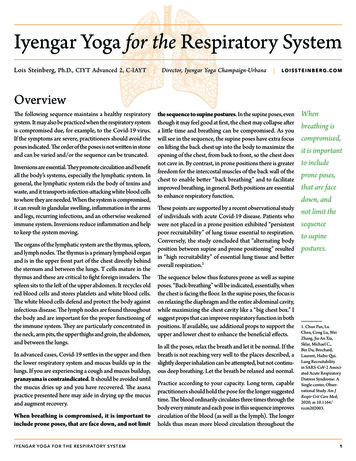
![N95 Respirators Training August 2012 Final - HS [Read-Only]](/img/20/n95-respirators-training.jpg)
